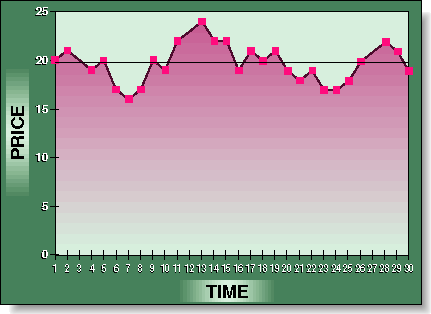INDICATORS

by Jack Karczewski
The trend of the market is key to most every technical approach available. But the market doesn't always trend. Here's how to use a statistical tool for determining if the market is in a trend.
Traders spend untold amounts of intellectual capital analyzing a market for clues about trend. We try to determine if there is a trend present, when it began, if it has reversed or broken down. The methods employed to interpret this information range from simple chart analysis to sophisticated computer algorithms. Even simple moving averages can become quite complex when the permutations and combinations of moving averages, their various lengths, crossovers and forms such as simple, weighted and exponential, are considered.
I use one analytical method in particular to identify trends. This technique gives not only the direction, but the slope, the magnitude of the error of the prediction and the reliability of the forecast of the trend. The statistical method is referred to as linear regression. This tool has become more readily available to traders with the current standard software.
There is a mystique that surrounds this simple tool, and many traders shun it because they don't understand its concept. There are many things that linear regression can and cannot do in explaining the concept of trend. Linear regression will not solve all of the problems of analyzing trends, but understanding the nature of the indicator and the ancillary statistics associated with its computation will provide a better understanding of market dynamics.
A LOOK AT MOVING AVERAGES
Most traders use simple moving averages, so let's take a look at the strengths and weaknesses of moving averages as a trend indicator and compare them with the linear regression method.
Moving averages are essentially a smoothing technique. By averaging past data, the moving average filters the noise associated with any time series datastream. This is true whether you are observing daily, hourly, monthly or any discrete data.
Moving averages present two fundamental problems for analysts. First, the average is just that -- an average price that should be plotted or centered midway through the data interval. If a 20-day simple moving average is being used, the result is the average price of the data centered on the data 10 days back. Most technical analysis programs will shift the result to be current with the day or week. Conceptually, trends persist, and the moving average is the proxy for the current trend. As long as your current data is above the moving average and the moving average is rising, the trend is up. If the current data is below a falling moving average, the trend is down. Numerous variations of this technique exist, and many traders have employed them at one time or another.
The second problem with moving averages is the arbitrary selection of the lookback period. The selection of the interval depends on the trader's requirements and the attributes of the market in question. Short intervals are responsive to market changes and retain much of the noise that the average seeks to eliminate, while long intervals eliminate much of the noise but are not particularly responsive to the market movement. Traders have devised many systems to correct these problems, but that discussion is beyond our scope here.

Jack Karczewski is a Paine Webber broker in Scottsdale, AZ.